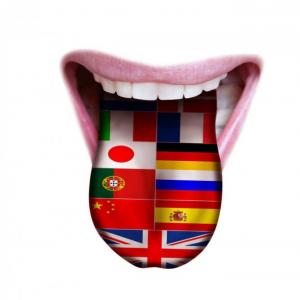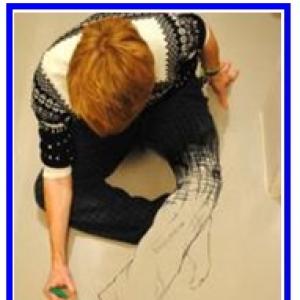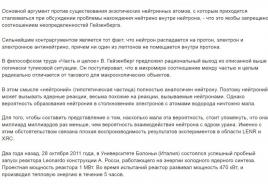Solving problems C4 from the exam in mathematics (beginning).
If all sides of the polygon touch the circle, then the circle is called inscribed in a polygonand the polygon is described around this circle. In Figure 231, the quadrilateral EFMN is described around a circle with center O, and the quadrilateral DKMN is not described around this circle, since the side DK does not touch the circle.
Fig. 231
In Figure 232, triangle ABC is described around a circle with center O.

Fig. 232
Let us prove the theorem on a circle inscribed in a triangle.
Theorem
Evidence
Consider an arbitrary triangle ABC and denote by the letter O the point of intersection of its bisectors. Let us draw from point O the perpendiculars OK, OL and ОМ, respectively, to the sides AB, BC and CA (see Fig. 232). Since point O is equidistant from the sides of the triangle ABC, then OK \u003d OL \u003d ОМ. Therefore, a circle with center O of radius OK passes through points K, L and M. The sides of triangle ABC touch this circle at points K, L, M, since they are perpendicular to the radii OK, OL and OM. This means that a circle with center O of radius OK is inscribed in triangle ABC. The theorem is proved.
Remark 1
Note that only one circle can be inscribed in a triangle.
Indeed, let us assume that two circles can be inscribed in a triangle. Then the center of each circle is equidistant from the sides of the triangle and, therefore, coincides with the point O of intersection of the bisectors of the triangle, and the radius is equal to the distance from point O to the sides of the triangle. Therefore, these circles coincide.
Remark 2
Let's turn to Figure 232. We see that the triangle ABC is composed of three triangles: ABO, BCO and CAO. If in each of these triangles we take the side of triangle ABC as the base, then the height will be the radius r of the circle inscribed in triangle ABC. Therefore, the area S of the triangle ABC is expressed by the formula

Thus,
Remark 3
Unlike a triangle not every quadrilateral can be inscribed with a circle.
Consider, for example, a rectangle whose adjacent sides are not equal, that is, a rectangle that is not a square. It is clear that in such a rectangle you can "place" a circle touching its three sides (Fig. 233, a), but you cannot "place" a circle so that it touches all four of its sides, that is, you cannot inscribe a circle. If a circle can be inscribed into a quadrilateral, then its sides have the following remarkable property:

Fig. 233
This property is easy to establish using Figure 233, b, in which equal segments of tangents are designated by the same letters. Indeed, AB + CD \u003d a + b + c + d, BC + AD-a + b + c + d, therefore AB + CD \u003d BC + AD. It turns out that the converse is also true:
Circumscribed circle
If all the vertices of the polygon lie on a circle, then the circle is called described near a polygon, and a polygon - inscribed into this circle. In Figure 234, the quadrilateral ABCD is inscribed in a circle with the center O, and the quadrilateral AECD is not inscribed in this circle, since the vertex E does not lie on the circle.

Fig. 234
The triangle ABC in Figure 235 is inscribed in a circle with center O.

Fig. 235
Let us prove the theorem on a circle circumscribed about a triangle.
Theorem
Evidence
Consider an arbitrary triangle ABC. Let us denote by the letter O the point of intersection of the perpendiculars to its sides and draw the segments OA, OB and OS (Fig. 235). Since point O is equidistant from the vertices of the triangle ABC, then O A \u003d OB \u003d OS. Therefore, a circle with center O of radius OA passes through all three vertices of the triangle and, therefore, is described around the triangle ABC. The theorem is proved.
Remark 1
Note that only one circle can be described around a triangle.
Indeed, let us assume that two circles can be described around a triangle. Then the center of each of them is equidistant from its vertices and therefore coincides with the point O of the intersection of the mid-perpendiculars to the sides of the triangle, and the radius is equal to the distance from point O to the vertices of the triangle. Therefore, these circles coincide.
Remark 2
Unlike a triangle it is not always possible to describe a circle around a quadrilateral.
For example, you cannot describe a circle around a diamond that is not a square (explain why). If a circle can be described around a quadrilateral, then its corners have the following remarkable property:
This property is easy to establish if we turn to Figure 236 and use the inscribed angle theorem. Indeed,
whence follows

Fig. 236
It turns out that the opposite is also true:
Tasks
689. In an isosceles triangle, the base is 10 cm, and the side is 13 cm. Find the radius of the circle inscribed in this triangle.
690. Find the base of an isosceles triangle if the center of the inscribed circle divides the height drawn to the base in a ratio of 12: 5, counting from the top, and the side is 60 cm.
691. The point of tangency of a circle inscribed in isosceles triangle, divides one of the lateral sides into segments equal to 3 cm and 4 cm, counting from the base. Find the perimeter of the triangle.
692. A circle is inscribed in triangle ABC, which touches the sides AB, BC and CA at points P, Q and R. Find AP, PB, BQ, QC, CB, RA if AB \u003d 10 cm, BC \u003d 12 cm, CA \u003d 5 cm.
693. A circle of radius r is inscribed in a right-angled triangle. Find the perimeter of the triangle if: a) the hypotenuse is 26 cm, r \u003d 4 cm; b) the point of contact divides the hypotenuse into segments equal to 5 cm and 12 cm.
694. Find the diameter of a circle inscribed in a right-angled triangle if the hypotenuse of the triangle is c and the sum of the legs is m.
695. The sum of two opposite sides of the described quadrilateral is 15 cm. Find the perimeter of this quadrilateral.
696. Prove that if a circle can be inscribed into a parallelogram, then this parallelogram is a rhombus.
697. Prove that the area of \u200b\u200bthe circumscribed polygon is equal to half the product of its perimeter by the radius of the inscribed circle.
698. The sum of two opposite sides of the described quadrilateral is 12 cm, and the radius of the inscribed circle is 5 cm. Find the area of \u200b\u200bthe quadrilateral.
699. The sum of two opposite sides of the described quadrilateral is 10 cm, and its area is 12 cm 2. Find the radius of the circle inscribed in this quadrilateral.
700. Prove that a circle can be inscribed in any rhombus.
701. Draw three triangles: acute, rectangular, and obtuse. In each of them, write a circle.
702. Triangle ABC is inscribed in the circle so that AB is the diameter of the circle. Find the angles of the triangle if: a) BC \u003d 134 °; b) AC \u003d 70 °.
703. An isosceles triangle ABC with a base BC is inscribed in a circle. Find the angles of the triangle if BC \u003d 102 °.
704. A circle with center O is described about right triangle... a) Prove that point O is the midpoint of the hypotenuse. b) Find the sides of the triangle if the diameter of the circle is d, and one of sharp corners triangle is equal to α.
705. A circle is described around a right-angled triangle ABC with a right angle C. Find the radius of this circle if: a) AC \u003d 8 cm, BC \u003d 6 cm; b) AC \u003d 18 cm, ∠B \u003d 30 °.
706. Find the side of an equilateral triangle if the radius of the circumscribed circle around it is 10 cm.
707. The angle opposite to the base of the isosceles triangle is 120 °, the lateral side of the triangle is 8 cm. Find the diameter of the circle circumscribed about this triangle.
708. Prove that you can describe a circle: a) around any rectangle; b) about any isosceles trapezoid.
709. Prove that if a circle can be described near a parallelogram, then this parallelogram is a rectangle.
710. Prove that if a circle can be circumscribed about a trapezoid, then this trapezoid is isosceles.
711. Draw three triangles: obtuse, rectangular and equilateral. For each of them, draw a circumscribed circle.
The time before the exam is running out trial exam are carried out more and more often, the nerves of schoolchildren and their teachers are tightened more and more. On the eve of the opening of the season of "intensive preparation" for the final and entrance exams, I suggest you practice solving C4 problems from the manual developed by the IIOO to prepare schoolchildren for the exam in mathematics. The problems are given with solutions, however, it would be useful to solve them first yourself.
Option 3. Triangle ABC is inscribed in a circle of radius 12. It is known that AB \u003d 6 and BC \u003d 4. Find AC.
Decision:
From the sine theorem for a triangle ABC we have:
From the basic trigonometric identity, we find that:
![]()
Then, by the cosine theorem for a triangle ABC we have for both cases:
![]()
Answer: √35 ± √15.
Option 5. In a triangle ABCheld heights BMand CN, Ois the center of the inscribed circle. It is known that BC \u003d24 , MN \u003d12. Find the radius of the circle circumscribed about the triangle BOC.
Decision:

Two possible cases: ∠A - sharp and ∠A - blunt
Two cases are possible:
1) Let ∠ A - sharp (left picture). Let us prove that the triangles AMN and ABC are similar. Indeed, the points B, N, M and C lie on a circle with a diameter BC, therefore ∠ NMB = ∠NCB, made of right triangles BAM and BNC:
∠AMN = 90 0 — ∠NMB,∠B \u003d90 0 —
∠NCB, which obviously implies the conclusion that ∠ AMN=
∠Bbesides ∠ A- common to both triangles, therefore, they are similar in two angles.
From a right triangle AMB: cos∠ A = AM/AB ANC: cos∠ A = AN/AC.The same ratios are, obviously, the aspect ratios in similar triangles AMN and ABC, from which it follows that cos∠ A \u003d NM/BC \u003d1/2, which means ∠ A \u003d60 0, Since the sum of the angles in a triangle is 180 0, ∠ B +∠C \u003d
120 0. The center of a circle inscribed in a triangle lies, as is known, at the point of intersection of its bisectors. From this we conclude that:
∠OBC +∠O CB \u003d
1/2 (∠ B +∠C) \u003d
60 0, which means ∠ BOC \u003d120 0. By the sine theorem for a triangle BOC we have: BC/ sin∠ BOC =
2Rwhere R R = 8√3.
2) Now let ∠ A - dull (right picture). From a right triangle ABM we find that cos∠ BAM = AM/AB, from a right triangle CAN we find that cos∠ CAN \u003d AN/AC. ∠BAM \u003d∠C AN since they are vertical, so AM/AB = AN/AC \u003d cos∠ BAM \u003d cos∠ BAC since the last two corners are adjacent. Means triangles ABC and ANM are similar in angle and two proportional sides. The similarity coefficient is cos∠ BAC \u003d MN /BC \u003d -1/2, and the angle itself ∠ BAC \u003d 120 0 .
Further reasoning is similar. Since the sum of the angles in a triangle is 180 0, ∠ B +∠C \u003d
60 0. The center of the circle inscribed in the triangle lies at the point of intersection of its bisectors, therefore:
∠OBC +∠O CB \u003d
1/2 (∠ B +∠C) \u003d
30 0, which means ∠ BOC \u003d150 0. By the sine theorem for a triangle BOC we have: BC/ sin∠ BOC =
2Rwhere R- the required radius of a circle circumscribed about a triangle. Hence: R = 24.
Answer: 8√3 or 24.
Option 8. The perimeter of an isosceles trapezoid is 52. It is known that a circle can be inscribed in this trapezoid, and the side is divided by a point of contact in a ratio of 4: 9. A straight line passing through the center of the circle and the apex of the trapezoid cuts off a triangle from the trapezoid. Find the ratio of the area of \u200b\u200bthis triangle to the area of \u200b\u200bthe trapezoid.
Decision:

Drawing for solving problem C4 with trapezoid
By the tangent line segment theorem KB = BP = PC = CQ = 4x, QD = DL = LA = AK = 9x, then the perimeter of the trapezoid is 4 (9 x + 4x) \u003d 52, whence x \u003d 1. From here we calculate lateral sides AB = CD \u003d 13 and base BC = 8, AD \u003d 18. Then AH = (AD — BC) / 2 \u003d 5. From a right-angled triangle BHA by the Pythagorean theorem, we find the height of the trapezoid BH \u003d 12, sin∠ A \u003d sin∠ D \u003d 12/13. The area of \u200b\u200bthe trapezoid is then S = (BC + AD) · BH/2 = 156.
Depending on which line is mentioned in the problem statement, two cases are possible:
1) Let this line pass through the vertex containing the smaller base of the trapezoid (in the figure, the line BM). The center of a circle inscribed in a corner lies on its bisector, that is, ∠ ABM = ∠MBC, ∠MBC = ∠AMB (as lying on parallel lines BC, AD and secant BM), hence ∠ ABM = ∠AMB and triangle ABM - isosceles, AM = AB \u003d 13. Then the area of \u200b\u200bthe triangle ABM \u003d 0.5 AB · AM Sin∠ A \u003d 0.5 13 13 12/13 \u003d 78, and the sought ratio is 78/156 \u003d 1/2.
2) Now let the straight line mentioned in the condition pass through the vertex containing the smaller base of the trapezoid (in the figure, the straight line AN). Let's perform an additional construction: extend the base BC and straight AN before crossing at point Y... We prove in a similar way that the triangle ABY - isosceles, AB = BY = 13, CY = BY — BC \u003d 5. Triangles CNY and AND are similar in two angles (∠ AND = ∠CNY as vertical, ∠ CYA = ∠YAD as criss-cross on parallel lines BC, AD and secant AY), hence DN : NC = AD : CY \u003d 18: 5, which means DN = 18/23 CD = 18/23 AB \u003d 234/23. Then the area of \u200b\u200bthe triangle ADN \u003d 0.5 AD · DN Sin∠ D \u003d 0.5 18 234/23 12/13 \u003d 1944/23, and the desired ratio is 162/299.
Answer: 1/2 or 162/299.
Sergey Valerievich
Sections: Maths
In the final geometry lessons, there is practically no time left to solve problems throughout the course as a whole. And in KIMs Unified State Exam Traditionally, tasks are included, the solution of which requires knowledge of planimetry on the topic "Inscribed and circumscribed circles". Therefore, the proposed material will help not only to remember this topic, but also to systematize the previously obtained knowledge on solving planimetric problems for inscribed and described circles, as well as prepare for solving such problems in the exam. In this case, it is assumed that the student at least at the minimum level owns the entire course of school geometry (planimetry).
The first and most important stage in solving a geometric problem is the construction of a drawing. It is impossible to learn how to solve sufficiently meaningful problems without developing solid skills in making "good" drawings, without developing a habit (even a reflex) not to start solving a problem until a "big and beautiful" drawing is made. As the main method for solving geometric problems, the algebraic method is put forward with the compilation of a subsequent algorithm. Putting the algebraic method at the forefront, it is necessary to warn against excessive enthusiasm for algebra and counting, do not forget that we are talking about geometric problems, and therefore, working on a problem, one should look for geometric features, learn to look and see geometry. Having selected two terms that determine the ability to solve geometric problems - a drawing plus a method, we add a third here - the possession of certain theorems and support problems, known geometric facts.
I. Necessary theorems and support problems for a circle inscribed in a triangle and a quadrangle and a circle in a triangle and a quadrangle. ( Appendix 1 )
II. Solving tasks using ready-made drawings (it is convenient to use an overhead scope).
At the same time, students orally explain the progress of solving problems, formulate theorems and support problems that are used in solving problems according to ready-made drawings.
Finished drawing |
Given |
Decision |
| AB \u003d BC | The tangent lines are equal: BM \u003d BK \u003d 5 AB \u003d BC \u003d 12 MC \u003d CN \u003d 7, AC \u003d 14, AK \u003d AN \u003d 7, PABC \u003d 12 + 12 + 14 \u003d 38 Answer: P ABC \u003d 38 |
|
| AB \u003d 6, |
The tangent line segments are equal: AB \u003d BC 1) 2) AB \u003d BC, because VO - bisector 3) ABC - equilateral, PABC \u003d 6 3 \u003d 18 Answer: P ABC \u003d 18 |
|
|
AD - circle diameter, AB \u003d 3, VD \u003d 4 1. Prove: NM AD 2. R \u003d? |
1. Because AD - diameter, then DB AN and AC DN, i.e. AC and DB are the heights АND, then NK is the heights, since they intersect at one point. So NM AD. 2.AD \u003d \u003d 5, R \u003d Answer: R \u003d 2.5 |
| R \u003d? | AC - diameter of a circle and hypotenuse of rectangular ABC, R \u003d \u003d 1.5 Answer: R \u003d 1.5 |
|
| AB \u003d 24, OK \u003d 5 |
О - the point of intersection of the perpendiculars to the sides. BKO - rectangular, VK \u003d AK \u003d 12, KO \u003d 5, VO \u003d \u003d 13 \u003d R Answer: R \u003d 13 |
III. Solving problems.
1. Find the perimeter of a right-angled triangle if the radius of the inscribed circle is 2 cm and the hypotenuse is 13 cm.
 |
Let AM \u003d AN \u003d x, then AC \u003d x + 2, CB \u003d 2 + 13 - x \u003d 15 - x (x + 2) 2 + (15 - x) 2 \u003d 169 x 2 - 13x + 30 \u003d 0 x 1 \u003d 10, x 2 \u003d 3; AC \u003d 6, CB \u003d 12; P \u003d 30 cm Answer: P \u003d 30 cm. |
2. The radius of the inscribed circle in a right-angled triangle is 3 cm, O is the center of the inscribed circle,,. Find the area of \u200b\u200ba triangle.
 |
AO - bisector, AKO - rectangular, sin \u003d sin 30 o \u003d AN \u003d AK \u003d \u003d 3, AC \u003d 3 + 3, tg 60 о \u003d, CB \u003d S ABC \u003d Answer: S \u003d cm2. |
3. The perimeter of the triangle 84. The point of tangency of the inscribed circle divides one of the sides into segments 12 and 14. Find the radius of the inscribed circle and the area ABC, if ОВ \u003d 18, O is the center of the inscribed circle.
4. In an isosceles triangle, the distance from the center of the inscribed circle to the apex of the unequal angle is 5 cm. The large side is 10 cm. Find the radius of the inscribed circle.
 |
OB \u003d 5, OM \u003d OB . = AH \u003d 2r, AHB - rectangular, 4r 2 \u003d 100 - (5 + r) 2, r 2 + 2r - 15 \u003d 0, r 1 \u003d - 5, r 2 \u003d 3 Answer: r \u003d 3 cm. |
5. The base of an isosceles triangle inscribed in a circle of radius 5 cm is 6 cm. Find the perimeter of the triangle.
| AHO - rectangular: OH \u003d 4, BH \u003d 4 + 5 \u003d 9, AB \u003d BC \u003d \u003d P \u003d Answer: P \u003d see |
6. The perimeter of triangle ABC is 72 cm. AB \u003d BC, AB: AC \u003d 13:10. Find the radius of a circle circumscribed about a triangle.
| AB + BC + AC \u003d 72, AC \u003d 20, AB \u003d BC \u003d \u003d 26, BH \u003d \u003d 24 BN \u003d NA \u003d 13, , R \u003d Answer: R \u003d see |
7. The base of an obtuse isosceles triangle is 24 cm, and the radius of the circumscribed circle is 13 cm. Find the side of the triangle.
8. The circle, the diameter of which is the AC of the triangle ABC, passes through the point of intersection of the medians of this triangle. Find the ratio of the length of the AC side to the length of the median drawn to it.
 |
AO \u003d OC \u003d R \u003d OM, BM \u003d 2R, BO \u003d 3R, Answer:. |
9. Find the area of \u200b\u200ban isosceles trapezoid circumscribed about a circle with a radius of 4, if it is known that the side of the trapezoid is 10.
 |
S ABCD \u003d Because incircle, then AB + CD \u003d AD + BC \u003d 20 h \u003d 2r \u003d 8, Answer: 80. |
10. Given a rhombus ABCD. The circle circumscribed about the triangle ABD intersects the large diagonal of the rhombus AC at point E. Find CE if AB \u003d, BD \u003d 16.
IV. Tasks for independent solution.
1. The radius of a circle inscribed in a right-angled triangle is 2 cm, and the radius of the circumscribed circle is 5 cm. Find the larger leg of the triangle.
Answer: (6; 8).
2. About an isosceles triangle with a base AC and an angle at the base of 75о, a circle with a center O is described. Find its radius if the area of \u200b\u200bthe BOC triangle is 16.
Answer: (8).
3. Find the radius of a circle inscribed in an acute-angled triangle ABC, if the height BH is 12 and it is known that,.
Answer: (4).
4. One of the legs of a right-angled triangle is 15, and the projection of the second leg to the hypotenuse is 16. Find the diameter of the circle circumscribed about this triangle.
Answer: (25).
5. A circle is inscribed in an isosceles triangle ABC. Parallel to its base AC, a tangent to the circle is drawn, intersecting the lateral sides at points D and E. Find the radius of the circle if DE \u003d 8, AC \u003d 18.
Answer: (6).
6. A circle is described around triangle ABC. The median of triangle AM \u200b\u200bis extended to the intersection with the circle at point K. Find side AC if AM \u003d 18, MK \u003d 8, BK \u003d 10.
Answer: (15).
7. A circle inscribed in an isosceles triangle touches its lateral sides at points K and A. Point K divides the side of this triangle into segments 15 and 10, counting from the base. Find the length of the line segment KA.
Answer: (12).
8. The angle B of the triangle ABC is 60 o, the radius of the circle circumscribed about ABC is 2. Find the radius of the circle passing through points A and C and the center of the circle inscribed in ABC.
Answer: (2).
9. The sides of the triangle are equal to 5, 6 and 7. Find the ratio of the segments into which the bisector of the larger angle of this triangle is divided by the center of the circle inscribed in the triangle.
Answer: (11: 7).
10. The radius of a circle inscribed in a right-angled triangle is equal to the half-difference of its legs. Find the ratio of the larger leg to the smaller one.
,. Find the hypotenuse and radius of the circle around the triangle.







